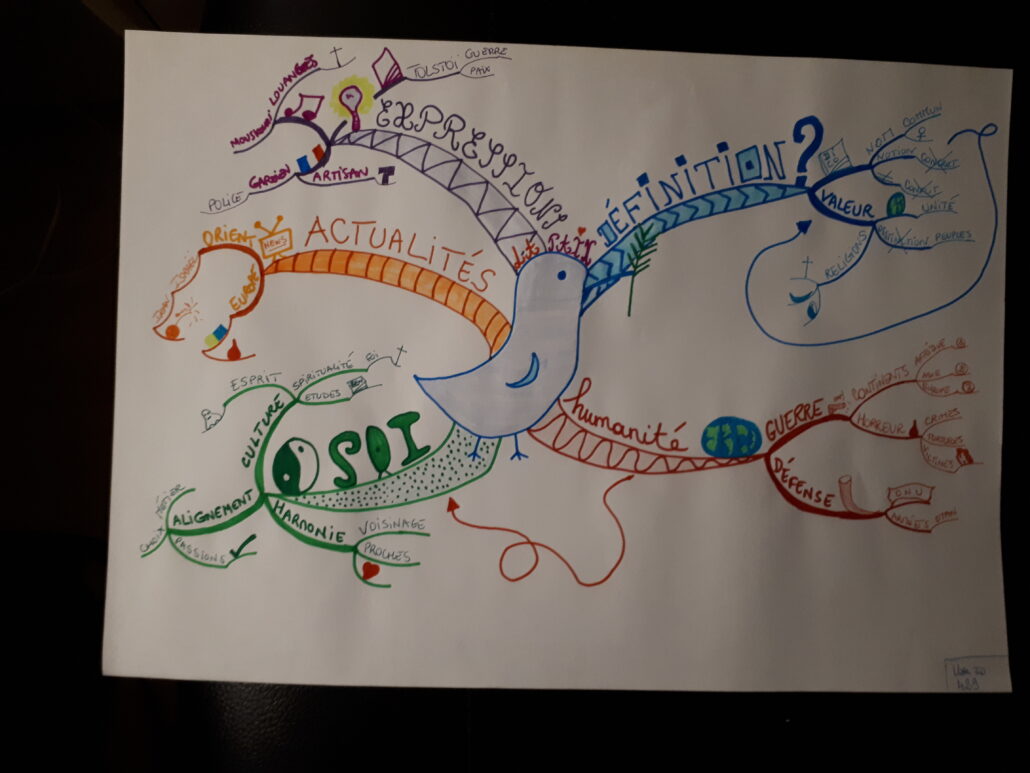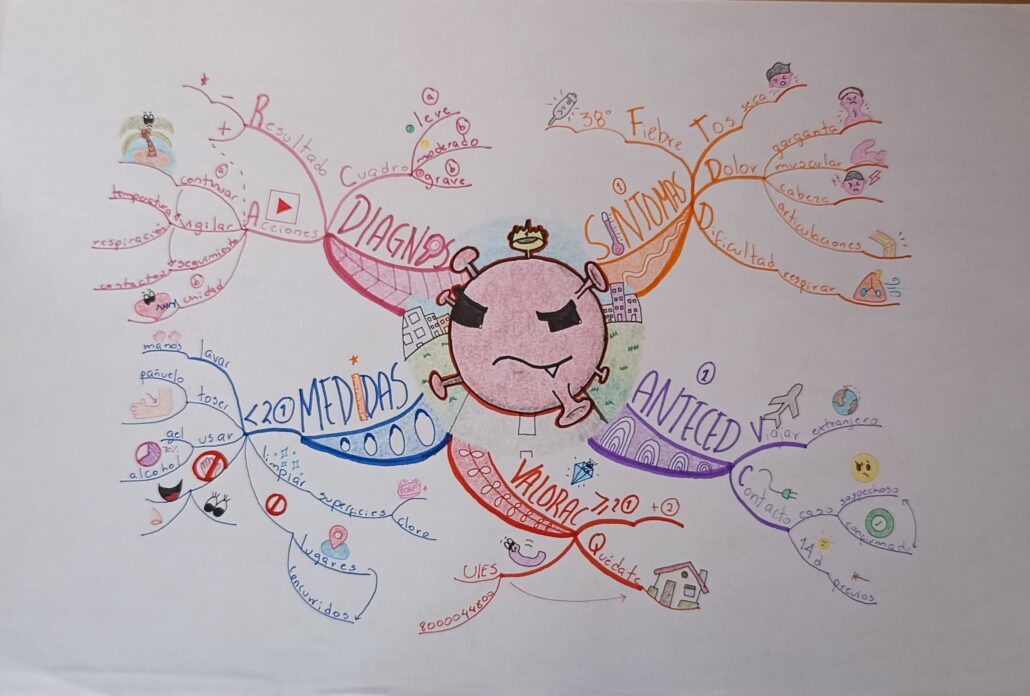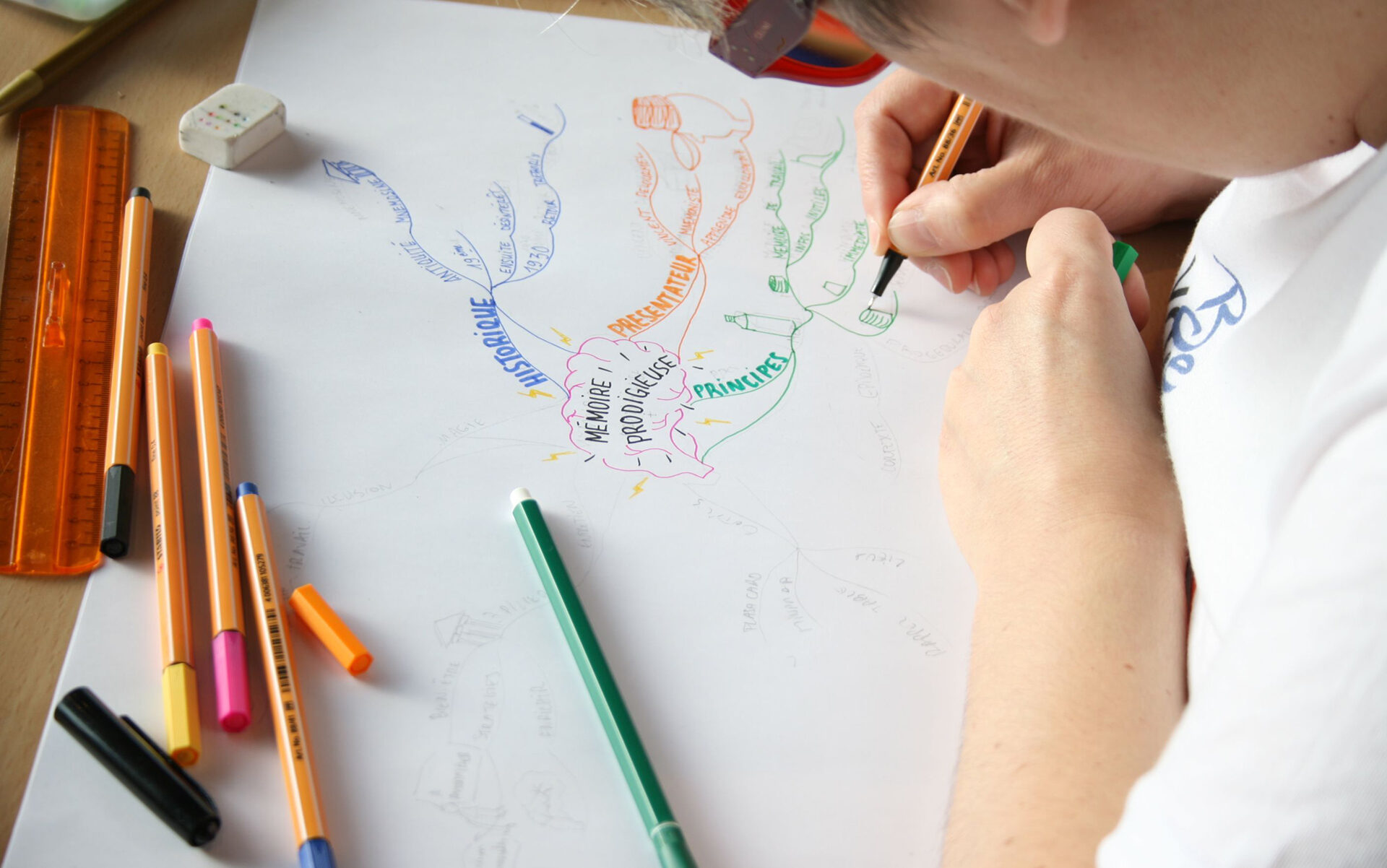An invention of Tony Buzan
Mind Mapping was developed by Tony Buzan, a pioneering expert in memory, brain function, and learning techniques. Inspired by visionary thinkers like Albert Einstein and Leonardo da Vinci, Buzan devised a method to organize information in a visually engaging and creative manner. His goal was to create a tool that would help individuals learn more effectively by harnessing the brain’s natural ability for radiant thinking. In 1990, Buzan further promoted this technique by establishing the World Mind Mapping Championships, encouraging people to challenge themselves and enhance cognitive skills such as concentration, memory, creativity, and mental agility.

Mind Map made by Elyn Batamio, member of the World Association of Brain Athletes
How does Mind Mapping help you use your brain more effectively?
The brain is a plastic and adaptable organ that can be transformed and improved throughout our lives. Through Mind Mapping, we can exercise the brain and develop several capacities simultaneously:
- Mental Agility
By performing multiple distinct tasks and switching between them quickly. - Creativity
By imagining keywords, representative drawings, the central theme of the map, etc. - Organization
By grouping information together, you « sculpt » your Mind Maps and your mind. - Efficiency
By synthesizing information and creating the structure for a thesis, project, or article, for example. - Memory Retention
A Mind Map serves not only to « organize » information but also to help memorize it. Using keywords, you generate memory hooks—connections between various pieces of information, whether they are new ones you want to learn or older ones you have already memorized. Connecting this knowledge, even from different domains, facilitates their retrieval by creating new pathways, making them easier to recall. Additionally, during a brainstorming session, all these cross-domain connections will allow you to use your knowledge in a more « creative » way.
How can you summarize a book using Mind Maps?
Understand Your Needs
If you want to study a book in its entirety, take notes as you go—either at the end of each chapter or every ten to twenty pages.
- If you’re only looking for targeted information, those points should naturally prompt note-taking.
- Finally, if you just want to retain a general impression of your reading, note-taking will depend on your feelings and the complexity of the book. You might, for instance, take notes at the end of each chapter or based on specific events or characters.
Read the Table of Contents Carefully
This way, the brain prepares to receive, sort, and classify the information it will receive. Furthermore, reading the table of contents often helps you predetermine the main branches of your Mind Map.
Elements of a Mind Map
Mind Mapping uses three essential elements: keywords, pictograms, and colors.
- A Keyword (= one branch)
The keyword is the UNIQUE term you choose based on your impressions and experiences when reading the information. It becomes the memory hook that allows you to retrieve all other related information. - A Pictogram
The pictogram is a simple and quick-to-execute drawing (it doesn’t require any drawing skills) with three advantages:- A simple doodle can convey a context or idea in its entirety.
- It uses only one branch, whereas several would be needed for keywords.
- Images are instantly understood by the brain, making Mind Maps even more « digestible. »
- Colors
Colors help categorize each group of branches and serve as « pre-memory hooks » because they hold different meanings for each of us.
Of course, you can use all three elements in your reading notes, but it’s not mandatory. The key is that your notes and coding make sense to you. Additionally, it will depend on your level of experience with Mind Mapping.
- Beginner Level:
Try to take notes in the form of keywords as much as possible. But if it doesn’t come naturally, don’t force it—try using short sentences instead. After your reading session, go back and convert them into keywords. - Amateur Level (you already practice Mind Mapping a bit):
Group the keywords and connect them with lines. - Experienced Level:
If the book is manageable, create your Mind Maps directly as you read. With a complex or unfamiliar topic, first transcribe the information into keywords and pictograms, then create your Mind Map.
How to become a Mind Mapper?
Creating a Mind Map is far from a passive activity—it’s a genuine workout for your brain!
That’s why Mind Mappers worldwide have joined the World Association of Brain Athletes (WABA), an organization partnered with Tony Buzan International. You can find more information at https://wabaleague.com.
You don’t need to be an expert right away; you can develop your skills over time with regular practice.
Here are some testimonials from WABA League members sharing how they train with Mind Maps.
Elyn Batamio

Why did you decide to join the WABA League?
Joining the WABA League allows me to push myself and continue practicing at least a little throughout the year.
How do you train?
For speed reading: I set an annual reading challenge for myself (an average of 50 books—last year I read 43 out of the 50 I planned) and I try to reach my goal using speed reading techniques. I also use Neoboost and other exercises like word games.
For Mind Mapping: I create spontaneous « draft » mind maps (with pencil, pen, etc.) during various meetings or after reading a book quickly, for example. The goal is to practice at least a little (even if just for a few minutes).
What does Mind Mapping bring to your life?
It optimizes my ability to memorize and synthesize information, and it allows me to work on my creativity (even though I can’t draw 🙂 ) to convey that information to others. I feel more confident in my personal abilities and the knowledge I’ve gained.
And speed reading?
At first, it allowed me to rekindle one of my passions: reading! And that despite a busier schedule.
It brings me a lot of pleasure, confidence, efficiency, and an incredible range of possibilities, both personally and professionally.
I feel mentally stronger.
PhD. Martha De la Campa

Why did you decide to join the WABA League?
I believe it´s important to keep the brain continuously active to keep it working efficiently over time.
How do you train?
Regularly, I make and use Mind Maps (either by hand or digital) to organize information, teach a class, learn a topic, synthesize a book, or even for a cooking recipe. I follow a low-carb diet, cook my meals, exercise, meditate, and avoid staying up late.
What does Mind Mapping and Speed Reading bring to your life?
I learned the Mind Mapping technique 15 years ago, and it has been part of my life ever since, as I have witnessed the power of this meta-tool in enhancing learning and memory processes. Speed reading has allowed me to grasp the essence of a book in a very short time.
Daphné Batamio
Why did you decide to join the WABA League?
The WABA League is a natural continuation of my brain sports practice, which I started with Passion d’Apprendre in 2018.
Like any athlete, top-tier coaching is essential to make effective progress, improve personal records, and participate in major tournaments.
How do you train?
For speed reading, I read 1 to 2 books of at least 100 pages per week, do my exercises with the « Neoboost » app, and follow the « Double Your Reading Speed in 30 Days » book. For mind mapping, I train to master the scoring grid and map in the conditions of the world championship, whether it’s a speech, a magazine, or a keyword.
What does Mind Mapping bring to your life?
Mind mapping allows me to plan my days with just « two strokes of the pencil. » It’s essential for permanently freeing my mental load in just 5 minutes.
This discipline has significantly increased my memory and synthesis capacity. Retaining and conveying a large amount of information is done quickly and effortlessly.
And speed reading?
Totally complementary to mind mapping, I’ve developed unprecedented reading comfort and endurance.
As a result, over the course of three months, I completed three professional training courses (two of which had final exams and certifications) while continuing to work full-time as an IT consultant. My final exam scores: 17/20 and 19/20. My certification scores: 15.2/20 and 16/20.
Join the WABA League now!
In partnership with Tony Buzan International and the World Mind Mapping, Speed Reading, and Memory Championships, the WABA League fosters a global community of brain athletes, offering resources for both beginners and seasoned competitors. Enroll now to receive a comprehensive Mind Mapping Workbook and a curated Video Course, designed to prepare you for success in the Mind Mapping Championship and enhance your cognitive skills. Click on the button bellow to join:

